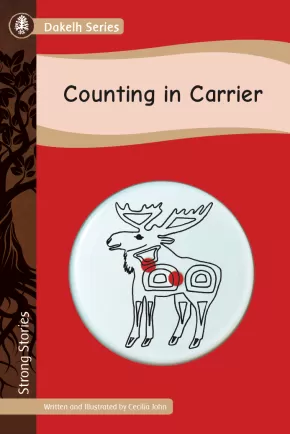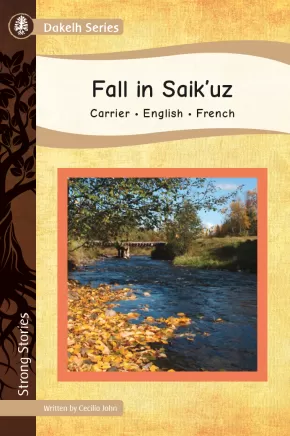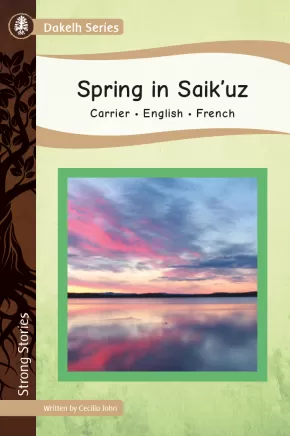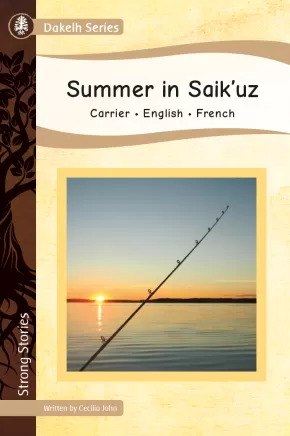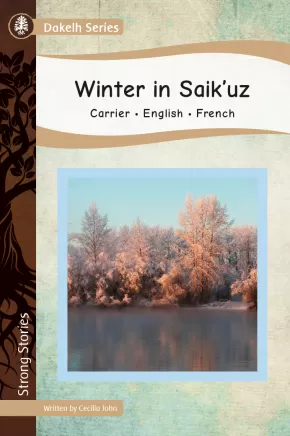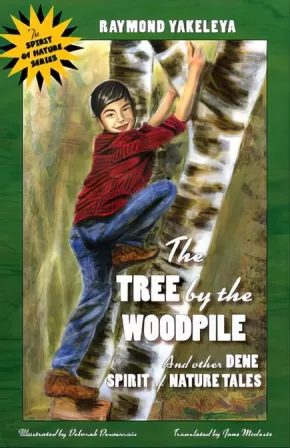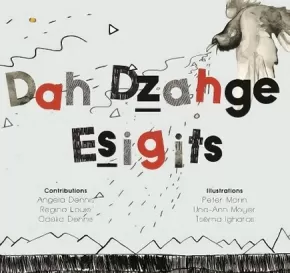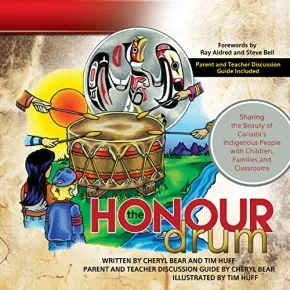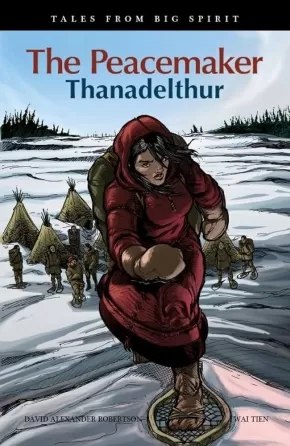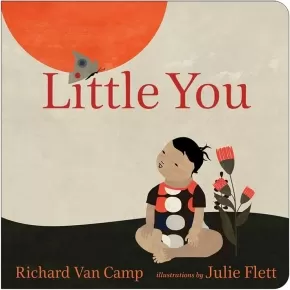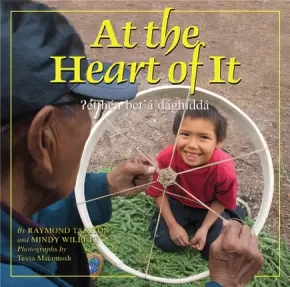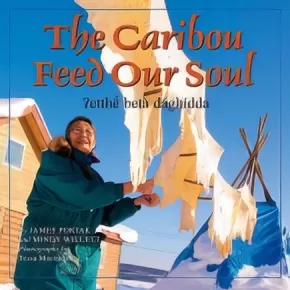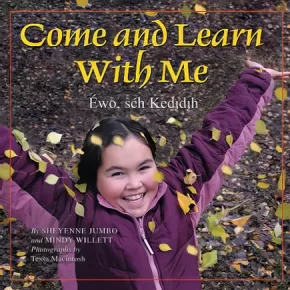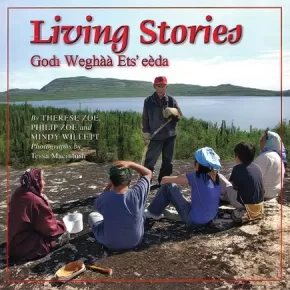
Dene
61
-
75
of
81 Results;
Sort By
Go To
of 6
Strong Stories Dakelh: Berry Picking with ‘Atsoo
 $9.95
$9.95

Format:
Paperback
Text Content Territories:
Indigenous Canadian; First Nations; Dene; Dakelh (Carrier);
ISBN / Barcode: 9781771743242
Synopsis:
Synopsis:
Travelling up to Sinkut Mountain was a favourite summer memory of the author, Cecilia John. She and her family would pick wild berries. Her ‘Atsoo (grandmother) taught her many things. Who is a person that teaches you many things?
Educator & Series Information
Recommended for primary students (grades 1-3).
Berry Picking with 'Atsoo is part of the Strong Stories: Dakelh series. Strong Stories focus on different First Nation territories from across Canada and the United States. These stories reflect the belief that our stories are the roots of our people, our lands and our cultures. It is from our stories that we grow and become strong and proud.
Additional Information
16 pages | 6.00" x 9.00" | ISBN: 9781771743242
Strong Stories Dakelh: Counting in Carrier
 $9.95
$9.95

Artists:
Format:
Paperback
Text Content Territories:
Indigenous Canadian; First Nations; Dene; Dakelh (Carrier);
ISBN / Barcode: 9781771743259
Synopsis:
Synopsis:
Counting to ten in Carrier is like counting to ten in English. But when you count people in Carrier it is not the same at all. Can you count in any other language?
Educator & Series Information
Recommended for primary students (grades 1-3).
Counting in Carrier is part of the Strong Stories: Dakelh series. Strong Stories focus on different First Nation territories from across Canada and the United States. These stories reflect the belief that our stories are the roots of our people, our lands and our cultures. It is from our stories that we grow and become strong and proud.
A dual-language resource written in Carrier and English.
Download a pronunciation guide for the Carrier words in the story: Counting in Carrier Pronunciation Guide
Additional Information
16 pages | 6.00" x 9.00" | ISBN: 9781771743259
Strong Stories Dakelh: Fall in Saik’uz
 $9.95
$9.95

Format:
Paperback
Text Content Territories:
Indigenous Canadian; First Nations; Dene; Dakelh (Carrier); Saik'uz;
ISBN / Barcode: 9781771743266
Synopsis:
Synopsis:
Come north to Saik’uz (sigh-kuz) located within the Dakelh (dah-kay-lth) Territory and see the leaves turn colour in fall! What is something that you love about fall?
Educator & Series Information
A triple-language resource written in Carrier, English and French.
Recommended for primary students (grades 1-3).
Download a pronunciation guide for the Carrier words in the story: Fall in Saik'uz Pronunciation Guide
Fall in Saik’uz is part of the Strong Stories: Dakelh series. Strong Stories focus on different First Nation territories from across Canada and the United States. These stories reflect the belief that our stories are the roots of our people, our lands and our cultures. It is from our stories that we grow and become strong and proud.
Additional Information
16 pages | 6.00" x 9.00" | ISBN: 9781771743266
Strong Stories Dakelh: Spring in Saik’uz
 $9.95
$9.95

Format:
Paperback
Text Content Territories:
Indigenous Canadian; First Nations; Dene; Dakelh (Carrier); Saik'uz;
ISBN / Barcode: 9781771743273
Synopsis:
Synopsis:
Come north to Saik’uz (sigh-kuz) located within the Dakelh (dah-kay-lth) Territory and see the trees bud and the birds come back! What is something that you love about spring?
Educator & Series Information
A triple-language resource written in Carrier, English and French.
Recommended for primary students (grades 1-3).
Download a pronunciation guide for the Carrier words in this story: Spring in Saik'uz Pronunciation Guide
Spring in Saik’uz is part of the Strong Stories: Dakelh series. Strong Stories focus on different First Nation territories from across Canada and the United States. These stories reflect the belief that our stories are the roots of our people, our lands and our cultures. It is from our stories that we grow and become strong and proud.
Additional Information
16 pages | 6.00" x 9.00" | ISBN: 9781771743273
Strong Stories Dakelh: Summer in Saik’uz
 $9.95
$9.95

Format:
Paperback
Text Content Territories:
Indigenous Canadian; First Nations; Dene; Dakelh (Carrier); Saik'uz;
ISBN / Barcode: 9781771743280
Synopsis:
Synopsis:
Come north to Saik’uz (sigh-kuz) located within the Dakelh (dah-kay-lth) Territory and see the berries and animals! What is something that you love about summer?
Educator & Series Information
A triple-language resource written in Carrier, English and French.
Recommended for primary students (grades 1-3).
Download a pronunciation guide for the Carrier words in the story: Summer in Saik'uz Pronunciation Guide
Summer in Saik’uz is part of the Strong Stories: Dakelh series. Strong Stories focus on different First Nation territories from across Canada and the United States. These stories reflect the belief that our stories are the roots of our people, our lands and our cultures. It is from our stories that we grow and become strong and proud.
Additional Information
16 pages | 6.00" x 9.00" | ISBN: 9781771743280
Strong Stories Dakelh: Winter in Saik’uz
 $9.95
$9.95

Format:
Paperback
Text Content Territories:
Indigenous Canadian; First Nations; Dene; Dakelh (Carrier); Saik'uz;
ISBN / Barcode: 9781771743297
Synopsis:
Synopsis:
Come north to Saik’uz (sigh-kuz) located within the Dakelh (dah-kay-lth) Territory and see what happens on cold winter days! What is something that you love about winter?
Educator & Series Information
A triple-language resource written in Carrier, English and French.
Recommended for primary students (grades 1-3).
Download a pronunciation guide for the Carrier words in this story: Winter in Saik'uz Pronunciation Guide
Winter in Saik’uz is part of the Strong Stories: Dakelh series. Strong Stories focus on different First Nation territories from across Canada and the United States. These stories reflect the belief that our stories are the roots of our people, our lands and our cultures. It is from our stories that we grow and become strong and proud.
Additional Information
16 pages | 6.00" x 9.00" | ISBN: 9781771743297
The Tree by the Woodpile: And Other Dene Spirit of Nature Tales
$16.95
Artists:
Format:
Paperback
Text Content Territories:
Indigenous Canadian; First Nations; Dene;
ISBN / Barcode: 9781988824031
Synopsis:
Synopsis:
“With the passing of many of our Elders, the telling of these stories becomes more valuable than ever.” — Raymond Yakeleya
The Tree by the Woodpile is a story about a First Nations boy who is told an enchanting tale by his grandmother about how an old tree by the woodpile provides food and shelter for the birds and animals of the North. Other stories in the book are “The Wolf,” and “The Mountain, the Wind, and the Wildflowers.” The stories are suffused with Newet'sine, the Creator and Spirit of Nature, who brings a message of how we must to cherish our land.
Educator & Series Information
The book, written in English and Dene for middle-grade children, ages 7 to 12, supports the "First Peoples Principles of Learning," particularly recognizing the role of Indigenous knowledge and learning embedded in memory, history, and story.
Recommended for these subject areas: English Language Arts, Science, Social Studies.
This is the first book in the UpRoute Indigenous Spirit of Nature Series.
Additional Information
64 pages | 5.50" x 8.50" | 25 b&w illustrations |18 colour illustrations | Dene translation by Jane Modeste (Dene).
Dah Dẕāhge Esigits: We Write Our Language
$19.95
Format:
Paperback
Text Content Territories:
Indigenous Canadian; First Nations; Dene; Tahltan (Nahanni);
ISBN / Barcode: 9781926886497
Synopsis:
Synopsis:
This beautifully illustrated book teaches the language of the Tahltan nation. The Tahltan alphabet is featured with the 47 sounds of the Tahltan language. Learners can match vowels, consonants and sounds to English equivalents and symbols. It is a resource for those who can already speak Tahltan, but wish to learn to read and write as well.
From the Preface:
The (Tahltan) Alphabet was developed by linguist Colin Carter in consultation with Tahltan speakers, Elders and language instructors...The (Tahltan) Alphabet...is phonetic, which means that every Tahltan sound is written with consistent symbols. This is different from the English alphabet where sounds can be written with various letters and combinations of them. The Tahltan alphabet is a summation of the 47 sounds of the Tahltan language. Carter and the Tahltan consultants decided to use English letters and represent specialized Tahltan sounds with more than one letter (eg dz, tl, ch) and other markings such as underlining, apostrophe and macron.
Educator Information
Recommended for Grades K-7 English Language Arts and courses in Indigenous language learning.
This book was coordinated by Edosdi Dr. Judy Thompson, developed by language leaders Angela Dennis, Regina Louis and Odelia Dennis, and illustrated by Una-Ann Moyer, Perer Morin and Tsema Igharas. The Telegraph Creek / Dease Lake dialect was contributed by Dah Dzahge Nodeside chair, Hostelma Pauline Hawkins in collaboration with fluent speakers Margery Inkster and Janet Vance from Telegraph Creek, BC. This book is produced with the intention to inspire future generations of Tahltan speakers and aid in Tahltan cultural sustainability.
Dr. Judy Thompson is an Assistant Professor in First Nations Studies at the University of Northern BC. Odelia Dennis teaches Tahltan as a second language to adults through the University of Victoria's Diploma in Indigenous Language Revitalization Program.
Additional Information
108 pages | 9.00" x 8.50" | colour and b&w drawings
The Honour Drum: Sharing the Beauty of Canada's Indigenous People with Children, Families and Classrooms
$12.95
Artists:
● Tim Huff
Format:
Paperback
Text Content Territories:
Indigenous Canadian;
ISBN / Barcode: 9781927355640
Synopsis:
Synopsis:
The Honour Drum is a uniquely envisioned and crafted project shared between two Canadian friends—an Indigenous woman from the West Coast and a non-Indigenous man from Ontario—to reach children, families and classrooms across Canada and around the world with a message of great beauty and truth that should not be ignored. This vibrant book is an important starting place for learning and insight that is vital and, for many people of all ages, overdue. The Honour Drum is a love letter to the Indigenous people of Canada and a humble bow to Indigenous cultures around the world.
Additional Information
42 pages | 8.50" x 8.50" | Paperback
The Peacemaker: Thanadelthur
$17.95
Format:
Paperback
Text Content Territories:
Indigenous Canadian; First Nations; Dene; Denesuline (Chipewyan);
ISBN / Barcode: 9781553794790
Synopsis:
Synopsis:
When Cole's teacher catches him drawing rather than listening in class, he gives Cole a special assignment: an oral presentation on an important Aboriginal figure. Cole will do almost anything to avoid speaking in public -- even feigning illness. But when he hear the story of the remarkable woman known as Thanadelthur -- peacemaker between the Cree and the Dene and interpreter for the governor of Fort York -- he is so inspired by her bravery, he overcomes his own fears.
Educator & Series Information
Tales from Big Spirit is a unique graphic novel series that delves into the stories of great Indigenous heroes from Canadian history—some already well known and others who deserve to be. Designed to correspond to grades 4–6 social studies curriculums across Canada, these full colour graphic novels could be used in literature circles, novel studies, and book clubs to facilitate discussion of social studies topics. These books will help students make historical connections while promoting important literacy skills.
Grades 4-6
Tales from the Big Spirit Series Teacher's Guide - Tales from the Big Spirit Series Teacher's Guide
The teacher's guide is designed to help classroom teacher's use the graphic novel series, Tales From Big Spirit, by David Alexander Robertson. The guide provides detailed lessons that meet a wide range of language arts and social studies goals, integrate Indigenous perspectives, and make curricular content more accessible to diverse learners.
The Peacemaker is available in French: L’ambassadrice de la paix : Thanadelthur
Additional Information
30 pages | 6.50" x 10.00"
Little You (BB)
$12.95
Artists:
Format:
Board Book
Text Content Territories:
Indigenous Canadian;
Grade Levels: Preschool; Kindergarten;
ISBN / Barcode: 9781459802483
Synopsis:
Synopsis:
Richard Van Camp, internationally renowned storyteller and bestselling author of the hugely successful Welcome Song for Baby: A Lullaby for Newborns, has partnered with talented illustrator Julie Flett to create a tender board book for babies and toddlers that honors the child in everyone. With its delightful contemporary illustrations, Little You is perfect to be shared, read or sung to all the little people in your life—and the new little ones on the way!
Awards
- 2013 BC Books for Babies winner
- 2015 R. Ross Annett Award winner
- 2016 American Indian Library Association Best Picture Book winner
Reviews
"Van Camp composes a lyrical ode to a newborn child, which is matched in its loveliness by Flett's exquisite, collage-like images of a young one with his or her parents. Both collaborators are of aboriginal Canadian descent, and the book will have particular appeal for families looking for nonwhite representations of tender family moments. But families of every size, shape, and background can appreciate sentiments like, 'You are life and breath adored/ You are us and so much more/ Little ember with growing light/ Feel our love as we hold you tight.'" — Publishers Weekly, March 2013
"A sweet little board book...Richard Van Camp has written a beautiful poem that describes the feelings of parenthood...The illustrations, done by Julie Flett, are both simple, and bold at the same time...and helped bring such beautiful words to life. I would recommend this book to anyone who enjoys curling up with their little one with a good book. It's a nice quick little read, that captured my little one's attention right away. It's got a great message that I hope she'll remember for the rest of her life." — Just Trying to Let it Be blog, May 2013
"The spreads lovingly depict a young child growing from infancy to toddlerhood...The text has the gentle cadence of a lullaby...Flett, who is of Cree Métis heritage, gives each character tawny skin, almond-shaped eyes and dark hair. This, combined with her sophisticated and simple style, allows her featured family to represent relatively broad branches of the human family. The art, with the look of cut-paper collage, uses curved forms and playful prints to flesh out the affectionate tableaux...The soothing rhythms of the language and the affection of the scenes are right on target. A poetic and joyful celebration." — Kirkus Reviews, August 2013
Educator Information
This book is available in French: Tout petit toi
This book is also available in a dual-language English and Anishinaabemowin hardcover format: Little You / Gidagaashiinh
Additional Information
24 pages | 7.00" x 7.00"
24 pages | 7.00" x 7.00"
At the Heart of It: Dene dzó t’áré
$19.95
Format:
Hardcover
Text Content Territories:
Indigenous Canadian; First Nations; Dene; North Slavey (Sahtu);
ISBN / Barcode: 9781897252697
Synopsis:
Synopsis:
Raymond Taniton is Sahtugot'ine, which means "people from the Sahtu or Great Bear Lake." He lives in Deline, Northwest Territories, on the shore of Sahtu, Canada's largest and most pristine lake. Raymond, former chief, is one of his community's many gifted leaders.
In At the Heart of It, the seventh book in The Land is Our Storybook series, Raymond shows readers how to make a traditional Dene drum with the help of his father, Alfred, who is a leader and the "keeper of the drum." Raymond shares the importance of keeping traditions alive to maintaining a healthy community. He also introduces readers to Dene spiritual, political, and traditional leaders and explains why Deline is a leader in the NWT in terms of healthy places, people, and land. Sahtugot'ine have never given up their right and responsibility to look after and govern themselves. Join Raymond and find out what is at the heart of the rich history of the Sahtugot'ine.
Educator & Series Information
This book is part of the "The Land Is Our Storybook" series, which considers the diverse lands and cultures of Canada's Northwest Territories. Told in a uniquely diverse range of northern voices, with a child-centred approach, books in the series highlight each official Aboriginal language group in the NWT, revealing a richly textured picture of life in the North-on the trapline, around the campfire, in communities, at school, and within the outdoor school that is the land itself. The series celebrates the seasons, ages, genders, traditional activities, and communities of the NWT.
The stories are illustrated by the striking images of acclaimed northern photographer, Tessa Macintosh and depict the similarities in lifestyle between children of the North and South, as well as the marked cultural differences, and highlight the special relationship these First Nations people have with the land and how they are adapting to rapid change while remaining connected to the land. Images of the landscape and animals within it, of trapping, hunting, fishing, and bannock baking sit alongside pictures of children at school, swimming at recreation centres, and reading in libraries. Here is modern northern culture painted beautifully: a complex mix of the new and the old.
These wonderful books, written with a variety of provincial and territorial curricula in mind, are specially designed for the classroom and include special features such as glossaries relating details on animals biology and cultural definitions, regional and language maps. The text of the stories also have sidebars such as Our Stories, which contain the stories of the people and language group featured, and Our Words, which highlight words in the featured language that are important to the story.
Additional Information
|
The Caribou Feed Our Soul
$19.95
Artists:
Format:
Hardcover
Text Content Territories:
Indigenous Canadian; First Nations; Dene; Denesuline (Chipewyan);
ISBN / Barcode: 9781897252673
Synopsis:
Synopsis:
Pete Enzoe is Chipewyan Dene from Lutsel K’e, Northwest Territories, on the East Arm of Great Slave Lake. He is a hunter, fisher, and trapper. He sees his role in life as protector of the caribou and spends much of his time “reading” the land as he travels his peoples’ traditional areas. Pete also helps scientists to monitor the herd’s health and migration. In The Caribou Feed Our Soul, the sixth book in The Land is Our Storybook series, Pete takes readers on a respectful caribou harvest. Along the way, he shares creation stories about how his people are descendants of the caribou. He also describes the spiritual areas his community is trying to protect, including Thaidene Nene, which means “land of our ancestors.” Pete’s stories help the reader to understand the rich history of the Chipewyan Dene and their relationship with the caribou today.
Educator & Series Information
This is the sixth book in the "The Land Is Our Storybook" series, which considers the diverse lands and cultures of Canada's Northwest Territories. Told in a uniquely diverse range of northern voices, with a child-centred approach, books in the series highlight each official Aboriginal language group in the NWT, revealing a richly textured picture of life in the North-on the trapline, around the campfire, in communities, at school, and within the outdoor school that is the land itself. The series celebrates the seasons, ages, genders, traditional activities, and communities of the NWT.
The stories are illustrated by the striking images of acclaimed northern photographer, Tessa Macintosh and depict the similarities in lifestyle between children of the North and South, as well as the marked cultural differences, and highlight the special relationship these First Nations people have with the land and how they are adapting to rapid change while remaining connected to the land. Images of the landscape and animals within it, of trapping, hunting, fishing, and bannock baking sit alongside pictures of children at school, swimming at recreation centres, and reading in libraries. Here is modern northern culture painted beautifully: a complex mix of the new and the old.
These wonderful books, written with a variety of provincial and territorial curricula in mind, are specially designed for the classroom and include special features such as glossaries relating details on animals biology and cultural definitions, regional and language maps. The text of the stories also have sidebars such as Our Stories, which contain the stories of the people and language group featured, and Our Words, which highlight words in the featured language that are important to the story.
Recommended Grade Level: 2-7
Additional Information
|
Come and Learn With Me: Ewo, seh Kedjdjh
$19.95
Artists:
Format:
Hardcover
Text Content Territories:
Indigenous Canadian; First Nations; Dene;
ISBN / Barcode: 9781897252574
Synopsis:
Synopsis:
Nine-year-old Sheyenne lives in Sambaa K'e, Northwest Territories-that's Trout Lake in English. Come learn with her as she takes you on a journey to her community in the fall, the season of moose.
This is the fourth book in the popular series "The Land Is Our Storybook" and features the Dehcho region of the Dene. "The Land Is Our Storybook" is a series of books about the lands and cultures of Canada's Northwest Territories. In the books, storytellers, elders, and cultural leaders from the ten regions in the Territories share real stories of everyday life in the North today.
Reviews
"The non-fiction book is colorful with rich, brilliant photographs and maps. Well-organized . . . Intriguing facts are contained within this book, making it a valuable resource for in classrooms, libraries, and homes. Come and Learn With Me can be used with both Aboriginal and non-Aboriginal readers to learn about Trout Lake's daily life during the fall moose season. This book will help preserve and keep the Dene Yatie (used to be known as South Slavey) group's language and culture alive. It is an innovative teaching tool and a 'must have' to read." — CM magazine
"Readers would be hard pressed to find a book of better quality whether it be for information, text, illustrations, layout, photography, or overall presentation. The text is well written and informative. The text is enhanced by maps, glossary, sidebars, graphics and stunning photography." — Resource Links
Educator & Series Information
This book is part of the "The Land Is Our Storybook" series, which considers the diverse lands and cultures of Canada's Northwest Territories. Told in a uniquely diverse range of northern voices, with a child-centred approach, books in the series highlight each official Aboriginal language group in the NWT, revealing a richly textured picture of life in the North -- on the trapline, around the campfire, in communities, at school, and within the outdoor school that is the land itself. The series celebrates the seasons, ages, genders, traditional activities, and communities of the NWT.
The stories are illustrated by the striking images of acclaimed northern photographer, Tessa Macintosh and depict the similarities in lifestyle between children of the North and South, as well as the marked cultural differences, and highlight the special relationship these First Nations people have with the land and how they are adapting to rapid change while remaining connected to the land. Images of the landscape and animals within it, of trapping, hunting, fishing, and bannock baking sit alongside pictures of children at school, swimming at recreation centres, and reading in libraries. Here is modern northern culture painted beautifully: a complex mix of the new and the old.
These wonderful books, written with a variety of provincial and territorial curricula in mind, are specially designed for the classroom and include special features such as glossaries relating details on animals biology and cultural definitions, regional and language maps. The text of the stories also have sidebars such as Our Stories, which contain the stories of the people and language group featured, and Our Words, which highlight words in the featured language that are important to the story.
This resource is also available in French: Viens avec moi: Nous apprendrons ensemble!
Additional Information
32 pages | 8.00" x 8.00" | colour photographs and illustrations, map
Living Stories: Godi Weghàà Ets' eèda
$16.95
Artists:
Format:
Hardcover
Text Content Territories:
Indigenous Canadian; First Nations; Dene; Tlicho (Dogrib);
ISBN / Barcode: 9781897252444
Synopsis:
Synopsis:
The third title in "The Land is Our Storybook" series, by and about the people of the Northwest Territories, for readers at grade 4 - 7 level.
In Living Stories, Therese Zoe translates the stories and traditional wisdom of Tlicho Elders Philip Zoe and Elizabeth Chocolate.
Therese Zoe is a Tlicho woman from Gamèti in the Northwest Territories. She is a community health representative, a mother and grandmother, as well as a champion of ancestral skills and stories. In Living Stories, Therese shares her love for her community and translates the sacred stories and traditional wisdom of her brother-in-law, Philip Zoe, and his sister, Elizabeth Chocolate. As Therese writes, "You might look at our lands and think they are empty, but we do not go hungry. The land gives us our food and our shelter. It holds our stories and our histories. It gives us everything we need."
Join Tlicho young people, Shelinda, Forest, and Bradley, as they learn about making dry-fish, bows and arrows, and birch-bark baskets; the practices of old-time healers; as well as the sacred stories that tell the history of the Tlicho people. Some of the stories Philip relates in this book have never been written down before - his versions of sacred stories are a gift to young readers across Canada, to be used wisely. The Tlicho Nation was the first in the Northwest Territories to gain self-government. With Elders such as Philip and Elizabeth passing along their traditional wisdom to the young, as well as knowledge gained since the Tlicho first encountered European peoples, the Tlicho are showing how they are, "strong like two people."
Reviews
"Living Stories is a heartfelt tribute to the culture of the Tlicho or Dogrib nation. . . All of the information is presented in a very personal way so that young readers unfamiliar with the first nations culture in the north can realize this is a real way of life for some people, not something from 'long ago and far away'. . . Photographer Tessa Macintosh, a southerner whose children are Tlicho, has done a wonderful job of including pictures of the land and the people, some posed to represent the subject under discussions, many in cheerful candid shots." — CM Magazine
Educator & Series Information
This book is part of the "The Land Is Our Storybook" series, which considers the diverse lands and cultures of Canada's Northwest Territories. Told in a uniquely diverse range of northern voices, with a child-centred approach, books in the series highlight each official Aboriginal language group in the NWT, revealing a richly textured picture of life in the North-on the trapline, around the campfire, in communities, at school, and within the outdoor school that is the land itself. The series celebrates the seasons, ages, genders, traditional activities, and communities of the NWT.
The stories are illustrated by the striking images of acclaimed northern photographer, Tessa Macintosh and depict the similarities in lifestyle between children of the North and South, as well as the marked cultural differences, and highlight the special relationship these First Nations people have with the land and how they are adapting to rapid change while remaining connected to the land. Images of the landscape and animals within it, of trapping, hunting, fishing, and bannock baking sit alongside pictures of children at school, swimming at recreation centres, and reading in libraries. Here is modern northern culture painted beautifully: a complex mix of the new and the old.
These wonderful books, written with a variety of provincial and territorial curricula in mind, are specially designed for the classroom and include special features such as glossaries relating details on animals biology and cultural definitions, regional and language maps. The text of the stories also have sidebars such as Our Stories, which contain the stories of the people and language group featured, and Our Words, which highlight words in the featured language that are important to the story.
Recommended Grade Level: 4-7
This resource is also available in French: Nos histoires sont vivantes
Additional Information
32 pages | 8.00" x 8.00" | colour photographs and illustrations throughout
Sort By
Go To
of 6




